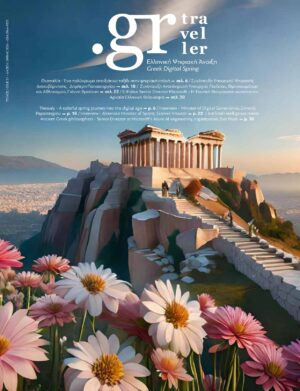
“[The Greeks] … relied on the Christian religion and the deep-rooted remnants of the Creed of Ancient Greece to survive. These elements formed the historical continuity of the Greeks. Elements that are […] alive in the customs and traditions […]. The heritage between the centuries.” Dora Stratou
Unique customs of Lent from Rhodes, Symi and Patmos that put us in the mood of a solemn period intertwined with the sacred services of the church and the deep faith of the people.

From Clean Monday until Holy Week, the Dodecanese observed a strict fast and began their preparations for the day of Lambri. Everyone participated from the first week of Lent in the various tasks, looking forward to the Resurrection. From the housewives who carefully cleaned the utensils from the “pascalera”, as they called the non-fasting foods, whitewashed the yards and prepared the buns. The young men and women who cleaned the churches and mournfully “dressed” the icons for M. Week. In Symi, everyone participated in the nights to prepare the most impressive spectacle of firecrackers and fireworks for the evening of the Resurrection.

All sorts of flowers from the “gavetes” of Patmos or from the courtyards of the houses of Rhodes and Symi, asparagus (wild daisies) from the Dodecanese countryside, rosemary, oregano, water lilies and various aromatic plants spread their fragrances and waited to decorate the holiest days of spring.
Sunday of the Adoration of the Cross

On the Sunday of the Pilgrimage of the Cross, the Symeans set out for the traditional pilgrimage to the Holy Monastery of Archangel Michael Panormitis. In the churches they handed out bundles of fragrant flowers and aromatic plants. In Paradisi, Rhodes, it was called “Sunday of Matsia”, from the word “Matsakia”. The believers put them in the iconostasis to dry them and then used them in the smokehouse (incense burner) to smoke (incense) the house.
Lazarus
A unique custom, which was eagerly awaited by young and old alike and was observed with great reverence. On the Sabbath of Lazarus, they dressed a child, usually a sixth-grader with a good voice, in church clothes (papadaki) and decorated him with armadillos and garlands of wild yellow daisies. This child played Lazarus and together with the other students and their teachers they would pass by the houses and sing songs. In every house, Lazarus would be made to kneel on a white cushion facing the East (Paradisi Rhodes) or in front of the icons and sing when it was his turn: “I saw fears, I saw terrors, I saw suffering and pains…”. The children’s baskets were filled with eggs, which in Rhodes were sent to the orphanages and to anyone in need. A touching story was told to us by Mrs Evangelia Panai from Paradisi Rhodes. In the old days, Michalis Papaconstantinou, son of the priest Loukas who was sacrificed in the Rally of Villanova, at Easter 1919, by Italian conquerors, lived in the village. Michalis was blind from birth, but this did not prevent him from climbing the high bays, collecting bark and knitting crosses over a metre high. Holding one of these crosses he would go from house to house and sing Lazarus.
Buns and eggs
The festive table could not be without Easter delicacies and especially the pretzels. The housewives started preparing them very early. In Symi, from the fifth week of Lent to the Saturday of Lazarus, while in Rhodes from the evening of M. Wednesday. In Symi they made two kinds of pretzels, the botyrene, which had no sugar and were intended for dips, and the dzaharena, some sprinkled with sugar like the kourabiedes and others without the added sugar. In Rhodes, they made the anevata, which took a long time to rise, the ammoniacaenas and the eggoules, on which they placed red eggs.

The preparation of the cookies was a collective effort. In the evenings, friends, neighbours and relatives gathered at the house of every housewife to knead and shape the buns. And the house smelled of butter and spices. They paid special attention to the best man’s eggs, to be as big as possible, elaborately decorated and with many eggs. They were, we would say, big buns, about the size of a round baking pan, and they would make dough ornaments and put as many red eggs on them as they could. Before they took it to their best men, they sewed it with water lily flowers. They also made snake-shaped buns (ophious), an ancient custom, as the snake was considered the protector of houses.
Ceremony of the Naptism

On the Holy Island of the Apocalypse, the customs of Holy Week have their roots in Byzantine times. One of these is the Rite of Naptiros, which takes place on M. Thursday. It is a representation of the Last Supper and prayer in the garden of Gethsemane by the twelve priests and monks of the Monastery of St. John the Theologian, dressed in Byzantine vestments.
Yaprakia
The delicacy that was not missing from any home at noon on M. Thursday. Vine leaves stuffed with fakoryzo and various herbs on Symi or with boiled chlorococuccia on Patmos, plenty of olive oil and dill.
The auctions of the Epitaph
In some villages of Rhodes, before or after the procession of the Epitaph, a kind of customary auction was held. In Psinthos the auction took place before the procession and whoever gave the most money had the right to pass first under the gate holding it in his hands. In Paradisi, after the procession, the three wooden crosses, which were decorated with flowers, would come out in “tirntism”. The crosses were returned without the flowers to the church to be decorated for the next year. The money was used to support the village library with Greek books, because under the Italians the Greek language was not taught in schools.
The thrones
The first Resurrection on the morning of M. Saturday is accompanied on all the islands, except Patmos, by the loud beating of the pews (the thrones as they are called in the Dodecanese). The noise should be as deafening as possible. The priest stitches the faithful with water leaves.
Happy Resurrection!
Thank you Mrs Ada Karagianni, President of EPOT Tourism Think Tank, Hospitality strategic Marketing Management specialist (Praxis Plus), Mrs Evangelia Panai from Paradisi Rhodes for the information.
Sources:
-
“Our village, the Messanagros of Rhodes”, Ioannis H. Karagiannis, Rhodes 2020
-
“Reminiscences from Old Symi”, Kostis V. Zachariou, Rhodes 1987
-
“The Psinthos I loved”, Rhodes 2004
-
“Byzantine roots of the Easter customs in Patmos”, Aristides Miaoulis,
ertnews.gr















